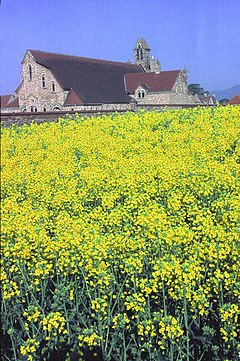Rosewell, Midlothian
| Rosewell | |
|---|---|
 St Matthew's Catholic Church |
|
| Rosewell shown within Midlothian | |
| OS grid reference | NT289627 |
| Council area | |
| Lieutenancy area | |
| Country | Scotland |
| Sovereign state | United Kingdom |
| Post town | ROSEWELL |
| Postcode district | EH24 |
| Dialling code | 0131 |
| Police | Scottish |
| Fire | Scottish |
| Ambulance | Scottish |
| EU Parliament | Scotland |
| UK Parliament | |
| Scottish Parliament | |
Rosewell is a former mining village in Midlothian, Scotland, south of Polton and south-west of Bonnyrigg. The village is in the civil parish of Lasswade and was previously a separate ecclesiastical parish, but has its own Community Council, namely Rosewell and District.
The population of the village is 1,566 (in 2011).
The colliery village was established by Archibald Hood, mining engineer and entrepreneur, who developed the Whitehill Colliery from 1856, which was located on the south-western edge of the village. He began a new shaft at the colliery in 1878, built railways for the mines (branching from the Peebles Railway) and erected well-designed houses for the miners, and also encouraged the establishment of a Co-operative Retail Society.
In 1890 he amalgamated his company with the mining interests of the Marquess of Lothian (9th marquess, 1833-1900) to form the Lothian Coal Company. The colliery was named after Whitehill House to the east and was also known as Rosewell. On 1 January 1947 the National Coal Board took over the colliery from the Lothian Coal Company, when mines in Britain were nationalised. The colliery had 3 deep shafts and one surface mine. It reached peak production in 1950, but closed in 1961.
Archibald Hood lived at Rosedale in the south of the village, which is now a category B listed building. This is a mid 19th century two storey gabled house, which was later used by the Lothian Coal Company as a house for its managers, in particular his son James Archibald Hood.
The Rosewell Institute, in Carnethie Street, was built for the Lothian Coal Company as a miners' institute in 1917. The Institute was built on an impressive scale with finely detailed sandstone features.
The Church in Rosewell was built 1871-72 and opened for worship 1874, when Rosewell became a separate ecclesiastical parish. The population of this new quoad sacra parish was recorded as 1,394 in 1881. It was re-united with Lasswade in 2008.
Rosewell was served by a railway station lying between Rosewell and Hawthornden. The station opened in 1855 under the name Hawthornden, but was renamed Rosewell and Hawthornden in 1928. It was served by the Peebles Railway, a branch line of the Waverley Line. Services ran from Peebles to Waverley Station in Edinburgh. The station wwas closed in 1962 but the line remained in use for goods traffic until 1967, although the colliery had already closed by then.
...
Wikipedia

